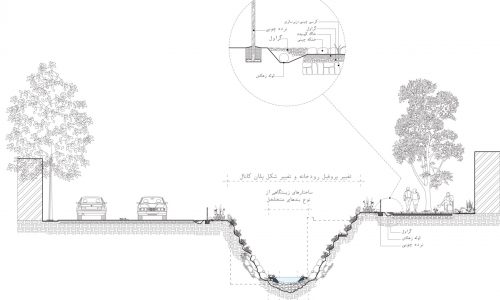Darband and Darabad Rivers Restoration: A strategic approach
Project Info
| Year: | 2015 |
| Type: | Commission |
| Program: | Strategic Plan |
| Client: | Tehran Engineering and Technical Consulting Organization (TETCO) |
| Joint Venture Company: | Sazeh Pardazi Iran |
| Lead Partner: | Negin Shahr Ayandah |
| Size: | 11 Kms |
| Location: | Tehran, Iran |
| Status: | Completed |
| Partner in Charge: | Mahmood Afsoos, Hamidreza Mousavi |
| Project Management: | Shadi Azizi |
| Project Coordination: | Farnaz Farshad, Mehdi Mosaferi, Nima Vahedi |
| Social Studies: | Marjan Shojaie, Mohammad Ameli |
| River Ecological Studies: | Shadnaz Azizi, Yalda Seirafi |
| Urban Planning/ Design: | Farnaz Farshad, Arezoo Khamesi, Mojtaba Safdarnejad, Yalda Seirafi, Shahin Shahriari, Zahra Fathi |
| Traffic Studies: | Hasan Khaksar |
| GIS: | Anahita kazemzadeh, Niloofar Ahmari, Hesam MirRahimi |
| Project Control: | Mahsa MirSamadi, Javad Hashemi |
| Creative Direction | Mohammadmahdi Zanjanian |
| Presentation: | Masoumeh Hosseinzadeh, Niloufar Soudmand |
| Photography: | Hesam MirRahimi, Farnaz Farshad, Arezoo Khamesi |
Rivers of Tehran, especially Darband and DarAbad have a double-edged essence. From one perspective, they hardly have a place in people’s image of the city , probably because of the simple fact that historically, the city’s water supply was based on a network of qanats. Hence, long before turning into canals, these rives were considerable barriers for development instead of a vital source of life. From another perspective, they are a significant asset in regards to current environmental risks resulting from climate change.
In spite of the importance of these natural resources, inharmonious development of the cities, not basically embracing the natural environment potentials has disrupted the supposed built-natural balance. Gradual receding of urban rivers surrendering the natural setting to artificial concrete structures is an eyesore yet familiar example. Past decades uncoordinated conducts and the destructive effects of simply eliminating rivers from development process have deprived both citizens and city management from its beneficiary so long. The trend led to even more reductive approach changing the canals to an unauthorized sewage network. Whereas urban rivers are believed of the ability to play an influential role in rekindling the balance between built urban spaces and nature.
Tehran’s Rivers and Qanats Restoration is a project risen from problems stated above and aims to change current approaches with a hope to revive natural organs of Tehran. This plan was delegated to joint ventures including a River Engineering and an Urban studies consultant in form of three coordinated projects for the seven rivers of Tehran and was financed by the Engineering and Development Organization of the City of Tehran (EDOCT).

علیرغم اهميت اين منبع طبيعی، گسترش ناموزون شهرها بدون بهرهگيری از توانهای محيطی طبيعی، تعادل ميان طبيعت و شهر را مختل نموده که از آن جمله میتوان به حذف تدريجی رودخانههای شهری از بستر شهر و ايجاد سازههای بتنی مصنوع به عنوان جايگزين عناصر طبيعی رودخانه اشاره نمود. به عبارتی اقدامات و دستکاریهای ناهماهنگ انجامشده در طول ساليان متمادی و دهههای گذشته و اثرات مخرب رويکرد حذف و محدودسازی رودخانهها و مجاری آبی، از ديرباز باعث بروز مشکلات جدی برای شهروندان و مديريت شهری شدهاست. اين روند تا جايی ادامه يافته که از مجاری آبی برای تخليه و هدايت فاضلاب شهری استفاده میگردد. حال آنکه رودخانههای شهری میتوانند نقش موثری در جهت تعادل بخشی ميان فضای انسان ساخت شهر و طبيعت و همچنین ارتباط انسان با طبيعت ايفا نمايند.
طرح احیا و ساماندهی رودخانهها و قنوات شهر تهران پروژهای است که از بطن همین مسائل و مشکلات و با هدف تغییر رویکرد حاکم و احیا اندامهای طبیعی شهر تهران تعریف شد. این طرح در قالب سه پروژه هماهنگ برای رودخانههای هفتگانه تهران در سازمان مشاور فنی و مهندسی شهر تهران تامین بودجه و برای انجام مطالعات و تدوین طرح به گروههای مشارکت شامل یک مشاور رودخانه و یک مشاور معمار – شهرساز سپرده شد.














